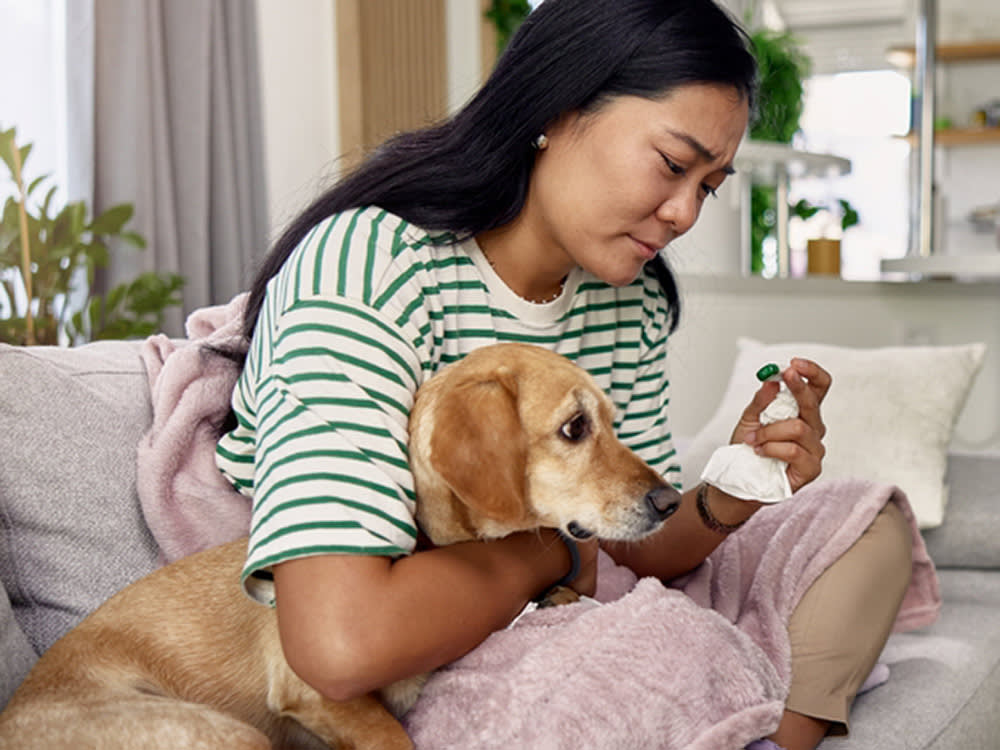How to Take Your Dog’s Temperature at Home
Don’t be scared. Follow these steps.
If your dog seems down and out, it’s normal to wonder if they have a fever. But how can you tell? By placing a hand on their forehead? Nope. By checking to see if their nose is cold and wet? Also, no. The belief that dog noses can tell us anything about their health is a myth. The best way to know if a dog has a fever is to actually measure a dog’s body temperature, and there are right and wrong ways to do it.
What is the normal temperature range for dogs?
The normal temperature range for dogs is between 99 and 102.5 degrees Fahrenheit. A dog’s temperature can vary quite a bit depending on the ambient temperature, humidity, and the dog’s level of excitement or anxiety. Health status can also have a major impact on a dog’s body temperature. Infection, inflammation, and overexertion can cause temperatures to rise. Pregnant dogs or dogs with health issues like congestive heart failure can have lower body temperatures.
Save on the litter with color-changing tech that helps you better care for your cat.
Why would I need to take my dog’s temperature?
Taking a dog’s temperature is not a routine part of at-home pet care. If your dog is acting fine and being kept in a normal environment, there’s no need to check your dog’s temperature. You may want to be proactive and monitor your dog’s temperature during strenuous outdoor activities to ensure that they are not at risk of becoming overheated.
If your dog is recovering from a serious infection, you may want to check periodically for a fever, especially if it seems like their recovery has plateaued. Pregnant dogs entering the early stages of labor can experience a temporary drop in body temperature, so some dog parents will monitor their dog’s temperature to help determine if puppies are coming soon.
What are the different methods to take a dog’s temperature?
There are a few ways to take a dog’s temperature, but first let’s discuss some things to avoid. First of all, don’t try to take your dog’s temperature orally. The risk of your dog biting or accidentally ingesting part of the thermometer is too high. And using your fingers to try to convince your dog to hold that thermometer under their tongue for 10 to 90 seconds is not the best idea.
Secondly, don’t use a glass thermometer. This removes the risk of a mishap leaving broken glass and loose mercury inside of your dog. And seriously, who even has those anymore? Go digital.
Methods you can consider for taking your dog’s temperature include:
Rectal Thermometer
Cover the tip of a digital thermometer with a water-based lubricant or petroleum jelly. Lift your dog’s tail and gently insert the thermometer one to two inches into the rectum. Rectal temperatures are considered the gold standard for measuring body temperatures in dogs and are the most reliable method.
Ear Thermometer
Veterinary ear thermometers are shaped to more easily fit into a pet’s ear canal. They are less invasive and tend to be faster than thermometers used to take rectal temperatures.
Infrared Thermometer
A non-contact, infrared thermometer uses light to detect how much radiation a body is emitting and uses that data to determine a body temperature. Studies have shown that infrared thermometers are often not accurate or reliable for measuring body temperature in dogs. If this method is chosen, aiming the thermometer at the gums (above the canine tooth) may give the best chance of getting a semi-reliable reading.
How often should I take my dog’s temperature?
You really shouldn’t need to take your dog’s temperature often, if ever. If your dog is recovering from an illness and you’ve been instructed to monitor their temperature at home, checking two or three times per day is sufficient.
How can I keep my dog calm while taking their temperature?
Some dogs will not tolerate rectal temperatures and the stress of forcing them to have their temperature taken can cause their temperature to spike and lead to an unreliable reading. Try to keep your dog calm during a temperature reading using these tips:
Have a calm demeanor and use a reassuring tone when speaking to your dog.
Use treats or rewards to create a positive association with the process.
Have a second person gently restrain your dog if needed.
Maintain a gentle and reassuring touch throughout the process.
When should I be concerned about my dog’s temperature?
Seek veterinary advice if your dog’s body temperature falls outside of the normal range of 99 to 102.5 degrees Fahrenheit , especially if it’s more than a degree outside of the range. Seek veterinary attention immediately if your dog also seems sick or weak.
What should I do if my dog has a high temperature?
If your dog’s body temperature is above 103.5 degrees Fahrenheit after being active outside, but they seem fine otherwise, provide a cool environment and fresh water and encourage them to rest. If they seem weak, lethargic, or nauseous, seek veterinary care immediately. Overexertion can lead to heat exhaustion or heat stroke. Dogs with temperatures over 105 degrees Fahrenheit need attention ASAP. You can try to cool them with cool wet towels and a fan while en route to a veterinary clinic. If your dog has not been active but seems sick and has a fever, talk to your vet.
What should I do if my dog has a low temperature?
If your dog’s body temperature is below 99 degrees Fahrenheit, seek veterinary advice. Move them to a warmer environment and try to warm them with blankets and towels. Don’t use heating pads, hot water bottles, heat lamps, or electric blankets due to risk for burns.
Can I use a human thermometer on my dog?
Digital human thermometers can be used to take rectal temperature with dogs. Pro tip: Label this thermometer appropriately so that no human decides to put it under their tongue in the future.
Healthy dogs don’t need their temperature checked regularly. Knowing how to check your dog’s temperature can be valuable for collecting useful information to determine if veterinary care should be sought right away. If your dog’s temperature is within the normal range but something’s not quite right, it is still best to contact a vet for advice.
FAQs (People Also Ask):
1) What should I do if my dog has a high temperature?
If a dog has a high temperature (especially over 104 degrees Fahrenheit), seek veterinary advice.
2) How often should I take my dog’s temperature?
Taking a dog’s temperature is not a routine part of pet care. If instructed to monitor your dog’s temperature at home, checking two to three times a day is sufficient.














